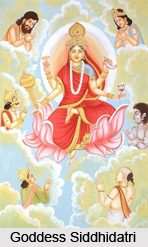 Goddess Siddhidatri is the ninth form of Goddess Durga among the Nava Durga. The goddess is worshipped on the ninth day of Navaratri. `Siddhi` is a Sanskrit term which means `perfection`.
Goddess Siddhidatri is the ninth form of Goddess Durga among the Nava Durga. The goddess is worshipped on the ninth day of Navaratri. `Siddhi` is a Sanskrit term which means `perfection`.
Legend of Goddess Siddhidatri
According to legend Lord Shiva received the `siddhis` by revering Maha Shakti. Through her blessings half of his body became like that of Goddess Shakti. Hence he is also known as `Ardhanarishvar`. As per the Hindu texts dev, danav, dandharva, kinnar, yaksh, manav all worship goddess Siddhidaatri. The siddhi that is provided by the goddess makes one realise that the whole universe is the Supreme Being or Brahman. Siddhidaatri provides her worshipper with knowledge and removes ignorance.
Attributes of Goddess Siddhidatri
Goddess Siddhidatri possesses four arms. With her lower right hand she holds a chakra and with the upper right hand she holds a mace. With the left lower hand she holds a conch shell and with her upper left hand she holds a lotus flower. She is seated on a lotus flower. The lion is her mount. The goddess provides all types of occult powers. She has the power to grant 26 different wishes to her worshippers. These achievements also known as Siddhi according to the Markandeya Purana can be categorised as 8 siddhis, Anima, Mahima, Garima, Laghima, Prapti, Prakaamya, Ishitva and Vashitva. According to the Brahmavaivarta Purana there are 18 types of achievements, DurShravana, Parkaayapraveshan, VakaSiddhi, Kalpavrushatva, Anima, Mahima, Garima, Ladhima, Prapti, Prakaamya, Ishitva, Vashitva, Sarvakaamaal, Saadhita, Sarvagynatva, Shrishti, Samharkaransaamarthya, Amaratva, Sarvanyayakatva, Bhavana and Siddhi. The following mantra is chanted while praying to the goddess.
Ya devi Sarvabhuteshu Ma Siddhidatri Rupenu Sansthitan |
Namastaseya Namastaseya Namastaseya Namoh Namah ||
This article is a stub. You can enrich by adding more information to it. Send your Write Up to content@indianetzone.com









